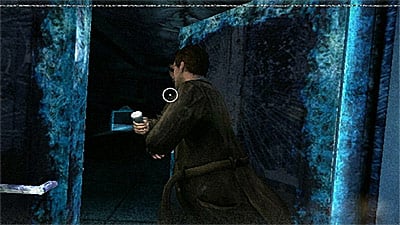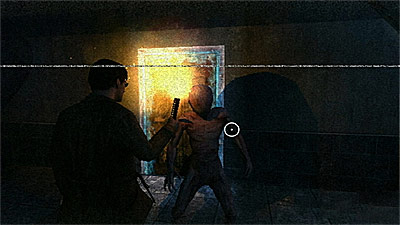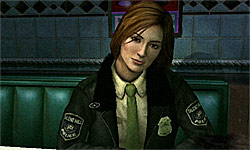Just Keep Running
Much of the popularity of the Silent Hill franchise stems from its handle on the psychology of fear. Although creatures with meaty faces and triangle-shaped craniums may sound ridiculous to the average person, simply mentioning Pyramid Head and the Bubble Head Nurses in the context of a Silent Hill game is enough to set even the bravest players into a panic. The newest entry in the Silent Hill Franchise, Shattered Memories does not take many cues from its predecessors, however. Instead of balancing terrifying survival horror gameplay with over-the-top enemies, Silent Hill: Shattered Memories gives you quizzes and running contests. Sure, there’s some fun-looking enemies, but if you are expecting anything truly terrifying, you’ve come to the wrong place.

The plot of Silent Hill is fairly simple and involves a desperate father’s quest for his little girl. The father, being a typical middle-aged man doesn’t have the skills necessary to fight off the nightmare of Silent Hill. As he runs through the levels, he discovers that not all is as it seems, and his memories of his daughter don’t exactly match up with reality; couple that with recurring nightmare sequences full of glowing doors and frozen ice and you’ve got one confusing plot.
Although the game’s story is somewhat confusing, the tale is threaded together by visits with a psychologist. This guy will ask you questions, and depending on your answers, certain elements will change in the game. Characters will behave differently around you, you’ll gain access to different areas in the game, and certain objects will appear.

Though this is a cool mechanic, I can’t say that it made enough of a difference to the core gameplay to make me really feel all that immersed in the game. Most of the instances where this is used are blatantly obvious and suffer from feeling a little too contrived. For instance, early in the game you’ll be able to color in a picture entitled “Happy Home.” And wouldn’t you know it, five minutes later you are walking up to a house which is supposed to be yours and has the color scheme you gave it in the picture. While the Vikings-themed purple and yellow home I designed for myself was certainly good for a laugh, it didn’t exactly incite fear or make me feel like the game was psychologically profiling me.
Of course, you’ll change more than just the color of the house, but other examples of this featured in-game feel just as contrived. A sexy calendar replacing a family photo, a teddy bear in place of a butchered bear, a bar replacing a diner, all these variables seem sort of neat, but don’t directly impact the gameplay and therefore have no real value in the context of the game or add to the gameplay. This facet is also relied on a bit too much to make the gameplay interesting.

While the big selling point of the game is the psychology of fear, the only way this game is going to scare you is if your biggest fear is of dying in a videogame. Since the main character is just a middle-aged guy with a flashlight, you can bet he’s no match for the nightmare of Silent Hill and will die over and over again. When you aren’t looking at pictures that your choices influenced (the game might as well have a big arrow pointing to all the changed items, they are featured so heavily), you’ll have to deal with the game’s terrible nightmare sequences. These involve running away from generic-looking baddies with gangly arms and seemingly mushy faces. The nightmare sequences aren’t terribly challenging, and the only “combat” that is to be found involves pressing a face button to throw a creature off you and then continue running. These sequences are terribly annoying, and running away for 5-10 minutes through glowing doors gets repetitive fast.
However, if we take out the sprint-heavy nightmares, there is actually quite a bit to explore in Silent Hill. While the game’s world is far from open, each stage has a fair amount of things to explore, and the ambitious player can go around photographing ghosts, gathering echo recordings, and finding mementos littered around the landscape. While these collection quests are certainly interesting, it really is a shame that the nightmare portions of the game aren’t as fun as the collection quests. Although you are supposed to be scared by the game psychologically profiling you, if the worst that happens is a picture on a wall changes, then the game isn’t really living up to its potential.

As far as control is concerned, this game is much better on the Wii. There are plenty of “puzzle” elements in the game where you can tell that motion control should be used, but instead the game gives you a cursor that you can place over certain elements and you can then use the alternate thumbstick to focus on something or the X button to interact. The puzzle elements are not exactly the strongest point in the game, and the tedious cursor controls just make them feel tacked on.
Even though the gameplay and plot are disappointing, one area of the game that is completely faithful to the original series is the audio. The music and sound effects in Silent Hill titles have a history of being top-notch, and this entry is no different. Music is eerie and foreboding and sound effects are subtle and menacing. The echo recordings are also masterfully done, and the voice over performances are wonderfully creepy.
I really had high hopes for Silent Hill: Shattered Memories. The idea of a game that adapts to your psychological profile is certainly intriguing, but the problem with Silent Hill is that they just didn’t push this feature far enough. Though the choices you make will influence the setting of the action in the game (and predictably, the ending as well), not enough was done to make the experience feel like it was customized to scare you. In fact, the only truly scary thing about the game is how terrible the nightmare sequences are. If you are a survival horror fan, prepare to be disappointed by Silent Hill: Shattered Memories.
RATING OUT OF 5 RATING DESCRIPTION 3.0 Graphics
Looks blurry, even for a last-gen port, and shadow flickering can become a problem in the game’s dark landscape. 3.2 Control
They work for the most part, as you’ll mostly just be holding L2 and the control stick for running. Still, puzzle elements with the on-screen cursor feel clunky. 4.3 Music / Sound FX / Voice Acting
Music is pitch perfect, and vocal performances sound convincing. 3.5 Play Value
The collection quests and bonus UFO ending make this one you’ll have to play through several times to get the full experience; ss long as you don’t mind lots of running. 3.4 Overall Rating – Fair
Not an average. See Rating legend above for a final score breakdown.
Game Features:
